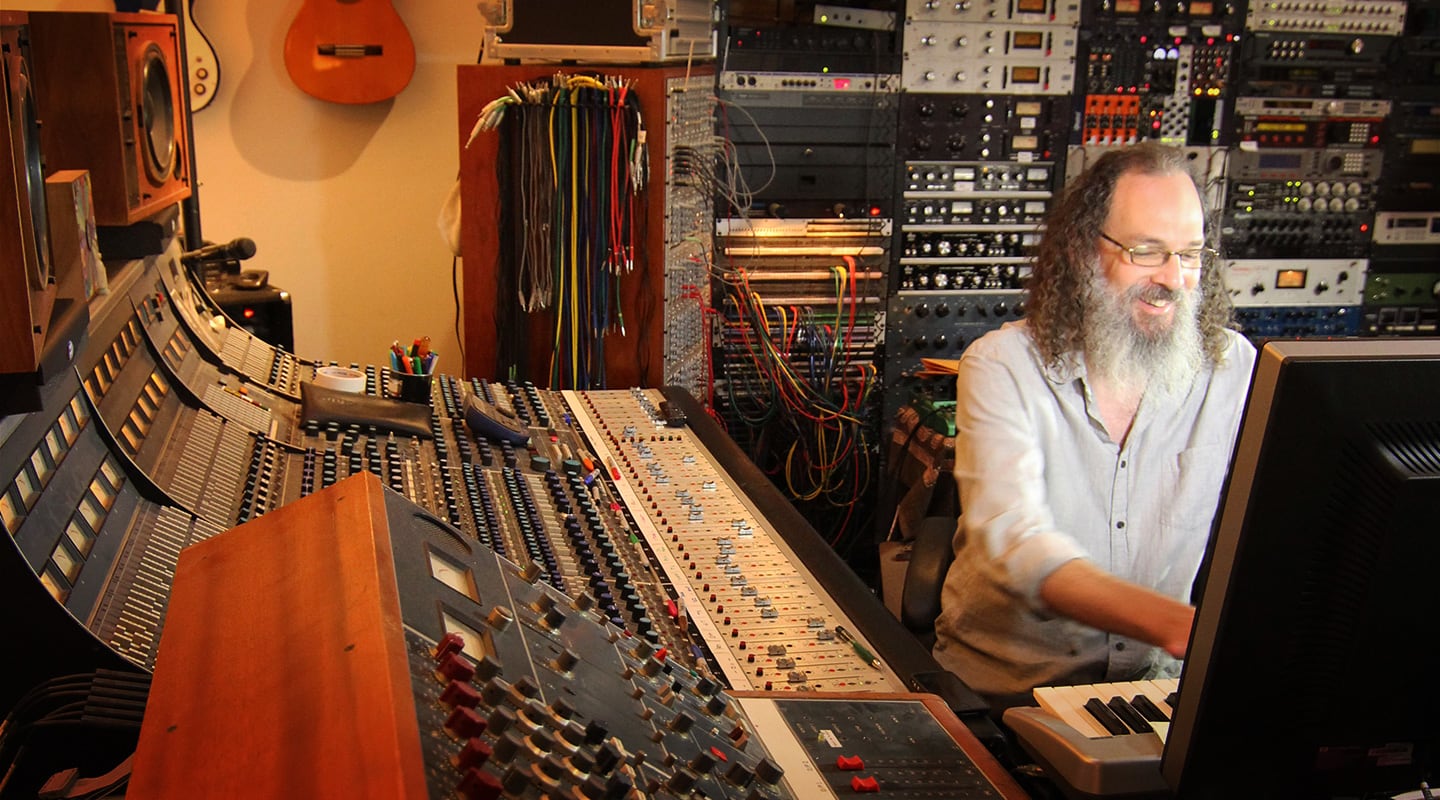
An Interview with Andrew Scheps
Multi-Grammy winning engineer Scheps just moved from LA to the UK, but not much has changed for the ‘in the box’ mixer. It’s still all about the song.
Interview: Allon Silove
Whether its mixing Adele, Green Day and Black Sabbath, engineering for The Red Hot Chili Peppers or working with producers like Rick Rubin, Andrew Scheps’ work has always stood out for being powerful and bold. Scheps isn’t afraid of making big moves. Over the last few years he’s migrated from being an ‘analogue man’ to mixing solely in-the-box. Recently, he moved to the UK after 25 years in Los Angeles. AT caught up with him to find out more about his current approach to mixing.
“It’s really interesting how little has actually changed,” said Scheps about the move, noting that it was all business by email and Skype in LA, it’s just a different time zone. “People ask if now I only work with UK acts instead of US acts, but no, it’s exactly the same.”
AudioTechnology: Did you move all your gear over with you?
Andrew Scheps: I had been looking for a studio to partner with who could take all my gear that I had accumulated over the years. It was impossible to find one in the US. Then Monnow Valley in Wales came up. I had worked there on and off over the years — it was one of the first studios I mixed and produced at in the UK — and always felt really comfortable and productive there. They needed to replace their SSL (E series with a G computer, I think) and my Neve 8068 Mk II (64 input, 16 bus, flying faders — technically, its two of them tied together) went in the control room as if the control room was built for it. All my outboard gear, instruments and microphones are there too. I always work there if I’m tracking — which doesn’t come up nearly as much lately! The people that run the studio are awesome. I would love it if they were always so busy that I could never work there when I need a tracking room. That’s the goal. Even though I mixed through all that equipment for years, it’s really the perfect desk for recording. Great pres, amazing EQs, it’s flexible, and never breaks.
AT: What is your current mixing setup?
AS: I’m currently using a MacBook Pro. For monitoring I use the HD native card with an HD IO (because the sound of those D to As is something I know) through a pair of beat-up Tannoy SRM10s powered by an old Crown DC300. If I’m working on headphones, its my Sony 7506s and a UAD Apollo Twin, because it has a nice big knob and has a decent headphone amp and I’ve just got an AudioFuse from Arturia that sounds great for headphones too. Then it’s Pro Tools with an Alpha Track controller or Pro Tools Dock for when I need to ride a fader — which is almost never! Oh, and a ton of plug-ins!
AT: You mix solely ‘in the box’ now, but do you miss analogue mixing?
AS: I’ve been mixing in the box for about five years and I don’t miss any part of mixing in analogue. The visceral experience of grabbing faders and having knobs that never changed was something I loved about sitting in front of my Neve. If something wasn’t working in the mix, you could pull all the faders down but leave all the EQ and the inserts, and then start the balance over again. To do that now, I would need a 100-fader controller, which would mean a lot of banking around. That would just irritate me. I was over that when it came to mixing. I can do that more easily now in a Pro Tools session with VCAs and I almost never pull everything down. You just mute and then add stuff back in, one at a time.
AT: Why do you think your move to ‘in the box’ caused such a stir in the industry?
AS: It was really weird, but seemed to be related to two things. The first was that I had been such an advocate of mixing analogue, and I think along the way I said something about analogue feeling ‘better’. I meant the hands-on visceral experience of grabbing faders and having knobs that never changed.
The second was these strange conspiracy theories that I was lying about being completely ‘in-the-box’ in order to sell plug-ins!
I think the reality is a lot of people who are aspiring to mix identify with people who have been successful and how they work. Then they get bummed out when the person changes how they do things because it’s easier to believe it’s the gear making it sound good, not the person: ‘If I had a Neve and a wall of outboard gear then I’d also be as good as that person!’ It takes away all the excuses and I guess people don’t like that. I remember feeling that way too, which is probably why I ended up with so much gear in the first place.
FAVOURITE RECORDING ENGINEER
Rudy Van Gelder. Those ’50s and ’60s Blue Note records are very difficult to top from a recording engineer perspective.
FAVOURITE MIXING ENGINEER
Tchad Blake is a huge inspiration for how bold he is. He hears stuff in a way that is unique among anybody who has ever mixed. There’s nobody who mixes like him.
FAVOURITE PRODUCER
Eno and Lanois. That group of recordings up until mid ’90s were just ‘god’ to me! They could do no wrong.
RECORD YOU WISH YOU HAD WORKED ON
Fearless
— Pink Floyd
The Dreaming
— Kate Bush
Salisbury Hill
— Peter Gabriel
WHAT WAS IT LIKE WORKING WITH MICHAEL JACKSON?
He was really nice. Absolutely the best singer I ever have or will ever work with. Ridiculously creative. For everything I worked with him on, he had the finished song in his head from the very beginning.
AT: Your Pro Tools template is pretty complex, how did you arrive at that layout?
AS: It started with me trying to be comfortable and familiar with the tools. As soon as you’re unfamiliar with your environment, you’re no longer mixing; you’re hunting around for stuff! Therefore, my template basically needed to be my patch bay. When I was on the console, there was a ton of gear always hooked up for all the parallel techniques. It would change mix to mix — I’d either use it or not, turn it down, or EQ it — but the basic tools were there. It would only be the individual source tracks that would change significantly from one mix to another. For example, when I was first building my template I needed a shared kick/snare compressor to replace the hardware that I’d used on every mix since Stadium Arcadium (Red Hot Chilli Peppers). Then there were things like a bass crush that I always had on the console. I never found one ‘in the box’ that I actually liked, so I don’t have one in the template. I’m also constantly trying to find a limiter that I don’t hate, for the backend of mixes. It’s evolving all the time. I recently opened up a Pro Tools session that was nearly three years old and it was almost un-recognisable!
AT: Do you have any must-have ‘desert island’ plug-ins?
AS: If I’m hearing something that’s not right, I use the EQ3, the Scheps 73, Lo Fi and SansAmp. Those come up all the time. I use a ton of other stuff in my template, but I don’t think of them in the same way.

AT: Parallel compression forms a big part of your signature mixing technique, but what makes your process unique?
AS: Parallel compression is not a new concept. It’s something that people have been doing for 50 years or more. However, I think that both the amount I use is maybe a little more than most people, and the way I use it is slightly different. Instead of using one parallel compressor for the kick and one for the snare, I use one for kick and snare. I also use three stereo compressors for drums. There’s also my Rear Bus compressor which is usually getting everything in the mix except the drums.
For me, the amount the compressors share is really important. I’ve always tried to understand what’s happening in my mixes and what each element in the signal chain is doing. It might be because I didn’t come up through the traditional studio assistant route. I had no idea how other people mixed. I was a programmer and a Pro Tools guy, I had to figure things out on my own by reading and talking to people. Discovering things for yourself takes much longer, but it meant I really understood the fundamentals. Recently, I was reading about how the famous physicist Richard Feynman learned. He had all these text books that showed established experiments regarding how the world works, but rather than simply accepting them, he re-created them. He wanted to understand why they worked. I did kind of the same thing with my mixing and that’s how I feel about my parallel/shared compression technique. I did it from scratch and it really made me understand what the mix is doing. It also means I can reach ‘inside’ my mix really quickly when it’s not doing what I want and fix it.
AT: You have a reputation for creating loud mixes. Has it always been your way?
AS: Yes. When I first started mixing I ended up on a lot of SSLs — which sound good when you push them — or on the Neve 8068 that Rick [Rubin] had in his Hollywood studio, which I mixed 99 Problems on. That board only sounded good with a certain amount of level going through it too. When it was quiet it sounded limp; when it was too loud, it was distorted. There was this sweet spot where you were really pushing the mix bus, with your master fader at -10dB.
With analogue gear, there’s a sweet spot because you’re dealing with power supplies that will start to react differently. Because modelled plug-ins are really good now and capture a lot of the non-linearity, they do kind of the same thing. However, with floating point architecture in software, gain structure at any particular point in the signal chain almost doesn’t matter any more. It’s not like the Pro Tools mixer has a sweet spot; it’s just math! What matters is the level going into a plug-in, particularly with dynamics because there are thresholds, and signals can clip. I do think a lot of the plug-ins I use feel right with a certain amount of level going through them. That’s just how I hear it. I get people telling me, ‘just mix quieter and use the volume knob.’ While that is true, I’m not relying on hitting the D-to-A converters at a certain level as part of my mix chain. It’s the way everything reacts to the levels. My mixes are actually quieter now than they were a year ago, or the year before that. I guess my taste changes too.
AT: Where do you start a mix?
AS: Drums. I know a lot of people will say the right answer is, ‘You always start with the vocal because it’s the most important thing!’ But for me, the vocal is last. I listen to everything early on so I know what’s there but tend to find the drums usually need to change the most. It’s a big deal for me; if the drums are driving the track properly, everything else can slot in around them. The drums will generally have the biggest problems too as they usually involve the most number of microphones. For some reason people think recording lots of microphones is a good substitute for having just a few microphones that sound really good. As if by putting up extra mics they’ll eventually make something usable from it!
I then lay out the mix exactly the same way I used to work on the console; left to right. Kick drum was always on fader one and the lead vocal was always on fader 24, with the rest of the kit and the instruments in between them. Then there would be keyboards or percussion off to the right, if I needed more than 24 faders. Which is exactly what I do now, only it’s top-to-bottom not left-to-right. I don’t ever use the mix window in Pro Tools.
WHAT WAS IT LIKE WORKING WITH RED HOT CHILI PEPPERS?
Working with them was a dream come true. To have a history with them and to feel like I’m part of their record-making world is great. They’re some of the nicest, most talented guys I know.
WHAT IS TONEQUAKE?
It’s a tiny boutique, indie label. It’s just me. It was started to put out the first Low Roar record and it’s a labour of love. The idea was to put out music that wouldn’t otherwise come out.
STILL WORK WITH INDIE ACTS?
The major label work covers me to mix indie acts. I just finished mixing a record for Farao and I’ll be working with My Brightest Diamond again — Shara Nova —
I mixed her first record at the same time as I was mixing Stadium Arcadium (that was on the console while her album was in the box). I love to work on music I love, so when I get the opportunity, and I can afford the time, I will absolutely do it.
ADVICE FOR ASPIRING MIXERS?
Mixers need to be the song’s biggest fan while working on it. You can’t ever feel you just have to get through it. I can’t mix something I don’t like. I have to get the ideal version of the song out of the speakers. If I don’t like the song, then there is no ideal version. There’s no point. You can’t just make the kick drum bigger, or the vocal louder. That isn’t mixing. You have to be excited by the song.
AT: How important is it that a producer or engineer understands music theory?
AS: I started out playing French horn, then trumpet; reading lots of different clefs. I don’t know if it should be requisite for every music producer or engineer. There are those who are amazing but aren’t musical or can’t talk about music theory and arrangement. Also, there are plenty of musicians in bands who have no music vocabulary whatsoever. It’s very important for what I do that I have musical knowledge; being able to count bars, and figure out the tempo and time signature. That helps me when working on a song. It’s also about having an appreciation of music. It helps that I listen to tons of classical and jazz, even though I don’t work on those types of records (I would love to do more of them). You get a sense of sound design in a totally different way if you listen to Ravel than if you listen to Eno. Anything that expands your palette and the universe you live in just gives you more to draw on.
AT: What was it like working with Waves on your two Waves’ Artist series plug-ins: Scheps 73 and Parallel Particles?
AS: It’s great working with them. They are super smart people. Mike Fradis, the project manager and leader for all the Artist series plug-ins, has an amazing ability to see what both Waves and the artist needs, and make it all happen without compromising either party. The process is very collaborative and by the time you are done working with them, there is nothing about the plug-in you feel you compromised on.
With Scheps 73, the concept was simple; it’s a 1073. However, the process was surprising. I had a Neve BCM10 with 10 1073s but I didn’t want to just choose my favourite one and model it. I wanted it to be a 1073, not my 1073. Choosing the one that sounds ‘different’ isn’t going to work on everything, but if I’m sitting in a studio with 1073s, they should all work. They were totally open to make a generic working-man’s 1073 as part of the Artist series. Parallel Particles was a more specific concept. I wanted to do something with parallel processing (it’s what I do!) and we couldn’t really work out a good way to do it. I wanted it to be shared compressors but that’s really difficult. It would have meant having two plug-ins that need to talk to each other. To its credit, Waves actually figured out some pretty cool ways to implement that process, but if you didn’t put all the plug-ins in the right place it wouldn’t work, which was not cool. I started thinking about the chains I use on individual instruments, rather than groups. I had it all mapped in my head so we went into Waves’ studio in Tel Aviv and programmed most of the audio processing for the plug-in in a day! I wanted a simple four-knob design for the interface, but there was plenty of backlash over the look of it. ‘It looks like a video game!’ My concept — which may be a flawed one — was that I didn’t want it to look like an audio processor; just four knobs that made you listen to what happens when you turn them so you would make a decision based on what you heard, not on how much the needle was deflecting. That took a long time but it’s really cool and I think it gives you a visual version of what you hear. Waves has this incredible team with a long history and are a group of people who are astounding in their work.









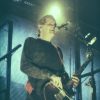


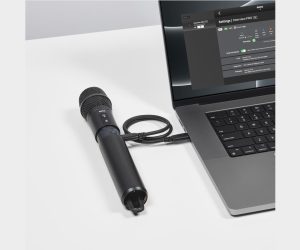


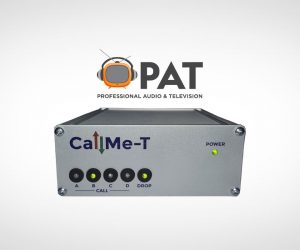



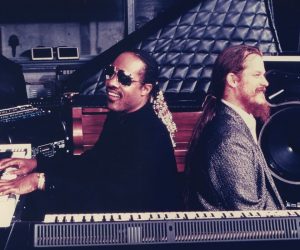

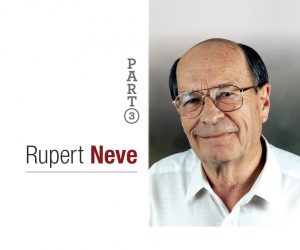




RESPONSES